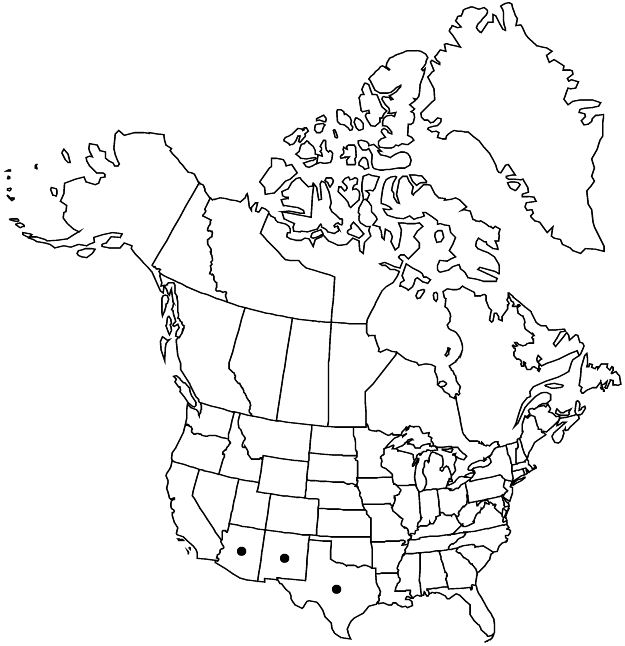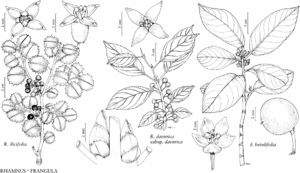Difference between revisions of "Frangula betulifolia"
Trudy Bot. Inst. Akad. Nauk S.S.S.R., Ser. 1, Fl. Sist. Vyssh. Rast. 8: 268. 1949.
FNA>Volume Importer |
FNA>Volume Importer |
||
| Line 31: | Line 31: | ||
|elevation=900–2800 m. | |elevation=900–2800 m. | ||
|distribution=Ariz.;N.Mex.;Tex.;Mexico (Chihuahua;Coahuila;Durango;Nuevo León;Sonora;Tamaulipas). | |distribution=Ariz.;N.Mex.;Tex.;Mexico (Chihuahua;Coahuila;Durango;Nuevo León;Sonora;Tamaulipas). | ||
| − | |discussion=<p>In the flora area, Frangula betulifolia is found in southeastern Arizona, the southern two-thirds of New Mexico, and trans-Pecos Texas. It and F. obovata are allopatric and morphologically distinct. C. B. Wolf (1938) considered a collection from Cochise County in southeastern Arizona, named as Rhamnus blumeri (Frangula ×blumeri), to be a hybrid between Frangula betulifolia and F. californica var. ursina; see the discussion of the latter taxon for more information.</p> | + | |discussion=<p>In the flora area, <i>Frangula betulifolia</i> is found in southeastern Arizona, the southern two-thirds of New Mexico, and trans-Pecos Texas. It and <i>F. obovata</i> are allopatric and morphologically distinct. C. B. Wolf (1938) considered a collection from Cochise County in southeastern Arizona, named as <i>Rhamnus</i> blumeri (<i>Frangula</i> ×blumeri), to be a hybrid between <i>Frangula betulifolia</i> and <i>F. californica</i> var. ursina; see the discussion of the latter taxon for more information.</p> |
|tables= | |tables= | ||
|references= | |references= | ||
| Line 55: | Line 55: | ||
|publication year=1949 | |publication year=1949 | ||
|special status=Selected by author to be illustrated | |special status=Selected by author to be illustrated | ||
| − | |source xml=https://jpend@bitbucket.org/aafc-mbb/fna-data-curation.git/src/ | + | |source xml=https://jpend@bitbucket.org/aafc-mbb/fna-data-curation.git/src/8f726806613d60c220dc4493de13607dd3150896/coarse_grained_fna_xml/V12/V12_528.xml |
|genus=Frangula | |genus=Frangula | ||
|species=Frangula betulifolia | |species=Frangula betulifolia | ||
Revision as of 14:47, 18 September 2019
Shrubs or small trees, 1–4 m. Stems brown to gray-brown, glabrous or pubescent. Leaves deciduous; petiole (2–)5–16 mm; blade yellowish green abaxially, green adaxially, elliptic to oblong, elliptic-ovate or narrowly ovate, (4–)4.5–10 x (2–)2.5–5.5 cm, 1.6–2.6(–2.9) times longer than wide, ± herbaceous, base obtuse to truncate or rounded, margins serrate to subcrenate, apex usually acute to obtuse, sometimes slightly acuminate, both surfaces hirtellous, glabrescent; secondary veins (8–)9–13 pairs. Inflorescences umbels, pedunculate, 2–20(–38)-flowered. Pedicels 3–7 mm. Stigmas 3-lobed. Drupes black, globose, 5–10 mm; stones (2–)3(–4).
Phenology: Flowering Apr–Jun.
Habitat: Moist canyons, stream banks, rocky slopes, cliff bases, ledges, ridges, roadsides, deciduous, coniferous, and mixed woodlands.
Elevation: 900–2800 m.
Distribution

Ariz., N.Mex., Tex., Mexico (Chihuahua, Coahuila, Durango, Nuevo León, Sonora, Tamaulipas).
Discussion
In the flora area, Frangula betulifolia is found in southeastern Arizona, the southern two-thirds of New Mexico, and trans-Pecos Texas. It and F. obovata are allopatric and morphologically distinct. C. B. Wolf (1938) considered a collection from Cochise County in southeastern Arizona, named as Rhamnus blumeri (Frangula ×blumeri), to be a hybrid between Frangula betulifolia and F. californica var. ursina; see the discussion of the latter taxon for more information.
Selected References
None.
